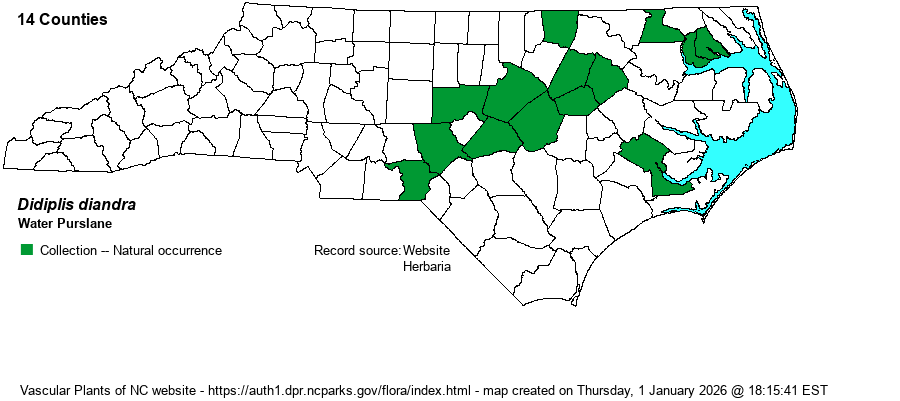| Author | (Nuttall ex de Candolle) A. Wood | |
| Distribution | Scattered in the Coastal Plain and eastern Piedmont, with most records close to the Fall Line. The BONAP atlas and Weakley's (2018) map show a record(s) for the Mountains, but no SERNEC specimen, nor any NCNHP record, is from this province, even though it lies within the broad range of this species.
This cryptic/aquatic species is easily overlooked, perhaps explaining its wide but fragmented or poorly documented range. It occurs from VA to southeastern MN, and south to central FL and eastern TX; many states have only a few county records. | |
| Abundance | Seemingly rare, with a number of the county records being rather old, though not necessarily indicating a decline in the state, owing to it growing mostly submerged and easily overlooked. The NCNHP tracks records as a Significantly Rare species. Though they give an S1 State rank, owing to the few current records, the website editors think it is overlooked and suggest a rank of S2? | |
| Habitat | This aquatic species grows in stagnant to slow-moving fresh water, in millponds, other lakes or ponds, or in slow-moving streams. | |
| Phenology | Blooms from April to October, and fruits shortly after flowering. | |
| Identification | This is a poorly known or little observed species in much of its range, especially in the East. It normally grows submerged, rarely above the water surface, such as on mud, where it would be much more likely to be observed. It has a very weak stem, branched, and only about 4-12 inches long. It has numerous paired (opposite) leaves, the submerged ones linear, sessile and truncate at the base, only about 3/4-inch long. Emergent leaves are shorter and narrowly elliptic, tapering at the base. The flowers are tiny and very few, from scattered leaf axils. They are greenish and essentially microscopic. This is a monotypic species (none others in its genus), but it will be easily overlooked, as flowers are lacking or tiny. Thankfully, a given pair of leaves tends to be at right angles to the pair above or below it, as opposed to all pairs aligned when viewed from above. Thus, the stem looks a bit "bushy" and 4-ranked when viewed from above. Don't look for flowers to help in the identification! | |
| Taxonomic Comments | Some older references, such as RAB (1968), named the species as Peplis diandra. As mentioned above, it is the sole member of the genus Didiplis.
| |
| Other Common Name(s) | Water Hedge | |
| State Rank | S1 [S2?] | |
| Global Rank | G3G4 | |
| State Status | SR-P | |
| US Status | | |
| USACE-agcp | OBL link |
| USACE-emp | OBL link |

